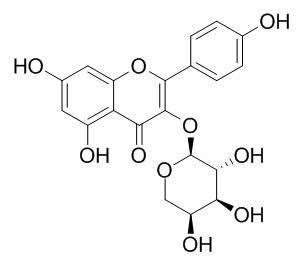Kaempferol 3-O-arabinoside
Kaempferol-3-O-α-D-arabinoside displays cytotoxic and high antioxidant activity.Kaempferol-3-O-arabinoside and kaempferol-3-O-glucoside can function as antioxidants in biological systems, particularly skin exposed to UV radiation by scavenging ROS, and protect cellular membrane against ROS; they can be applicable to new cosmeceuticals for antioxidant, antiaging, and antibacterial activity.
Inquire / Order:
manager@chemfaces.com
Technical Inquiries:
service@chemfaces.com
Tel:
+86-27-84237783
Fax:
+86-27-84254680
Address:
1 Building, No. 83, CheCheng Rd., Wuhan Economic and Technological Development Zone, Wuhan, Hubei 430056, PRC
Providing storage is as stated on the product vial and the vial is kept tightly sealed, the product can be stored for up to
24 months(2-8C).
Wherever possible, you should prepare and use solutions on the same day. However, if you need to make up stock solutions in advance, we recommend that you store the solution as aliquots in tightly sealed vials at -20C. Generally, these will be useable for up to two weeks. Before use, and prior to opening the vial we recommend that you allow your product to equilibrate to room temperature for at least 1 hour.
Need more advice on solubility, usage and handling? Please email to: service@chemfaces.com
The packaging of the product may have turned upside down during transportation, resulting in the natural compounds adhering to the neck or cap of the vial. take the vial out of its packaging and gently shake to let the compounds fall to the bottom of the vial. for liquid products, centrifuge at 200-500 RPM to gather the liquid at the bottom of the vial. try to avoid loss or contamination during handling.
Phytomedicine.2024, 125:155350.
Mol Med Rep.2023 Oct;28(4):193.
Journal of Functional Foods2019, 52:430-441
Int J Mol Sci.2021, 22(16):8604.
Mediators Inflamm.2016, 2016:7216912
Tissue Cell.2022, 78:101901.
Nutrients2023, 15(18), 4016.
Cancers (Basel).2023, 15(1):37.
J Mol Med (Berl).2018, 96(7):661-672
J Cell Physiol.2020, 10.1002
Related and Featured Products
Food Science and Technology Research.2006 Feb;12(1):31-37.
Identification of the Major Polyphenols in Boysenberry Leaves and Their Suppressive Effect on Carbon Tetrachloride-Induced Liver Injury in Mice.[Reference:
WebLink]
Seven polyphenols were isolated from leaves of New Zealand boysenberry.
METHODS AND RESULTS:
On the basis of spectroscopic analysis, the structures of these compounds were elucidated to be quercetin 3-O-glucuronide, quercetin 3-O-glucoside, quercetin 3-O-arabinoside, kaempferol 3-O-glucuronide, Kaempferol 3-O-arabinoside, kaempferol 3-O-(6"-O-p-coumaroyl)-glucoside, and ellagic acid. Increases in plasma aspartate aminotrasferase and alanine aminotrasferase activities in mice, induced with liver injury by the injection of carbon tetrachloride, were suppressed by oral administration of the polyphenol fraction prepared from the leaves, with ellagic acid as its effective component.
CONCLUSIONS:
Thus polyphenol fraction contained in boysenberry leaves may be effective in suppressing liver injury.
Journal of the Society of Cosmetic Scientists of Korea.2010,36(4):303-14.
Antibacterial, Antioxidative Activity and Component Analysis of Pinus koraiensis Leaf Extracts[Reference:
WebLink]
METHODS AND RESULTS:
In this study, the antibacterial, antioxidative effect and component analysis of Pinus koraiensis leaf extracts were investigated. MIC values of the ethyl acetate fraction from P. koraiensis leaf extracts on P. acnes, S. aureus, P. ovale, and E. coli were 0.06 %, 0.25 %, 0.13 % and 0.50 %, respectively. The results showed that the antibacterial activity of the ethyl acetate fraction on P. acnes, P. ovale. and S. aureus was more prominent. The aglycone fraction of P. koraiensis leaf extracts () showed more higher free radical (1,1-diphenyl-2-picrylhydrazyl, DPPH) scavenging activity (). Reactive oxygen species (ROS) scavenging activity () of P. koraiensis leaf extracts on ROS generated in -EDTA/ system was investigated using the luminol-dependent chemiluminescence assay. The 50 % ethanol extract () showed the most prominent ROS scavenging activity. Also the ethyl acetate () and the aglycone fraction () showed very high antoxidant activity. The protective effects of extract/fractions of P. koraiensis leaf extracts on the rose-bengal sensitized photohemolysis of human erythrocytes were investigated. The P. koraiensis leaf extracts showed cellular membrane protective effects in a concentration dependent manner (). TLC and HPLC chromatogram of the ethyl acetate fraction obtained from hydrolysis of P. koraiensis leaf extracts revealed 2 main bands (PK-4, PK-6) and peaks (peak 1, peak 2), which were identified as kaempferol-3-O-glucoside (PK-6, peak 1) and Kaempferol 3-O-arabinoside (PK-4, peak 2) by LC/ESI-MS/MS, respectively.
CONCLUSIONS:
These results indicate that extract/fractions of P. koraiensis can function as antioxidants in biological systems, particularly skin exposed to UV radiation by scavenging ROS, and protect cellular membrane against ROS. Extract/fractions of P. koraiensis can be applicable to new cosmeceuticals for antioxidant, antiaging, and antibacterial activity.
Nat. Prod. J., 2013, 3: 77-80.
Radical-Scavenging Activity, Cytotoxicity and Chemical Constituents of Euphorbia orthoclada from Madagascar.[Reference:
WebLink]
METHODS AND RESULTS:
Both cyclohexane and ethyl acetate fractions were toxic against brine shrimp larvae (Artemia salina) at a concentration of 10 μg/mL with mortality rates of 62% and 70%, respectively; however, the ethyl acetate extract proved to have the most effective antioxidant activity with an EC50 value of 3.45 ± 0.01 μg/mL. Five phenolic compounds 1-5 were isolated from the EtOAc extract by successive chromatographic procedures (silica gel, Sephadex LH-20). Among them, quercetin-3-O-α-D-arabinoside (2) (28.5 ± 0.11 μg/mL), kaempferol-3-O-β-D-glucoside (4) (37.2 ± 0.17 μg/mL), kaempferol-3-O-α-D-arabinoside (Kaempferol 3-O-arabinoside,3) (38.4 ± 0.13 μg/mL) and gallic acid (1) (55.22 ± 0.15 μg/mL) displayed the highest antioxidant activity, while 3,3',4'-trimethylellagic acid 4-O-glucoside (5) (63.90 ± 0.09 μg/mL) was more toxic than the other constituents on brine shrimp larvae when tested at 10 μg/mL (mortality rate of 65 %).
CONCLUSIONS:
The medicinal plant Euphorbia orthoclada - namely its chemical constituents - has been investigated for the first time in this project. The cytotoxic and antioxidant properties of the pure secondary metabolites explain the use of this plant in traditional medicine. Moreover, the isolation of compounds 2, 3 and 4 from E. orthoclada emphasizes that these metabolites may be considered as chemotaxonomic markers of the genus Euphorbia.



